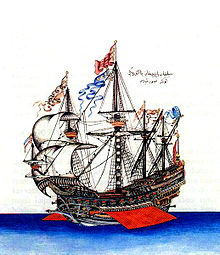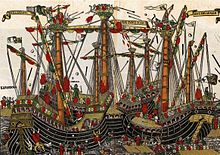Kemal Reis
Kemal Reis | |
|---|---|
| Born | 1451 Manisa, Anatolia Eyalet, Ottoman Empire |
| Died | 1511 (aged 59–60) Mediterranean Sea |
| Allegiance | Ottoman Empire |
| Service/ | Ottoman Navy |
| Years of service | c. 1470–1511 |
| Rank | Admiral |
| Battles/wars | Battle of Zonchio Battle of Modon |
Kemal Reis (c. 1451 – 1511) was an Ottoman privateer and admiral. He was also the paternal uncle of the famous Ottoman admiral and cartographer Piri Reis, who accompanied him in most of his important naval expeditions.
Background and early career
Kemal Reis was born in Manisa on the Aegean coast of the Ottoman Empire in circa 1451.[1] His full name was Ahmed Kemaleddin (Ahmet Kemalettin). His ancestry is disputed; some sources claim that he was born into a Turkish family,[1][2][3] while other sources indicate that he was born into a Greek family which converted from Christianity to Islam.[4][5][6] He became known in Europe, particularly in Italy and Spain, with names like Camali and Camalicchio.[1]


Kemal Reis started his career as the commander of the naval fleet belonging to the Sanjak Bey (Provincial Governor) of Eğriboz (present-day
In 1495 Kemal Reis was made an admiral of the Ottoman Navy by Sultan
Ottoman-Venetian Wars

In January 1499 Kemal Reis set sail from Constantinople with a force of 10 galleys and 4 other types of ships, and in July 1499 met with the huge Ottoman fleet which was sent to him by Davud Pasha and took over its command in order to wage a large scale war against the Republic of Venice. The Ottoman fleet consisted of 67 galleys, 20 galliots and circa 200 smaller vessels. In August 1499 Kemal Reis defeated the
In December 1499 the Venetians attacked
In January 1501 Kemal Reis set sail from Constantinople with a fleet of 36 galleys and fustas. In February 1501 he landed at the Island of
Operations in the West Mediterranean and the Atlantic Ocean
In July 1501 Kemal Reis, accompanied by his nephew
After leaving Valencia, still in August 1501, Kemal Reis headed south and bombarded the coastal defenses of
Return to the East Mediterranean
In May 1502 Kemal Reis set sail from
In March 1503 Kemal Reis set sail from Constantinople with his new ships and reached Gallipoli where he took over the command of the Ottoman fleet that was based there. However, he was caught by a severe illness and had to return to Constantinople for treatment, which lasted a long time and caused him to remain inactive between November 1503 and March 1505.
In March 1505 Kemal Reis was appointed with the task of intercepting the
Return to the West Mediterranean and Spain
In September 1505 Kemal Reis assaulted Sicily and captured 3 ships (one from the Republic of Ragusa, the other two from Sicily) off the Sicilian coast.
In January 1506 he made the Island of
and took them to Constantinople.In May 1506 Kemal Reis, commanding a force of 8 galliots and fustas, returned to the
Later operations in the East Mediterranean
In January 1507 Kemal Reis was appointed by
Final missions and death
Still in 1509 Kemal Reis sailed to the
In early 1511, after passing the lands of the Duchy of Naxos and being sighted for the last time in December 1510, 27 ships of the Ottoman cargo fleet were wrecked by a severe storm in the Mediterranean Sea, including the ship of Kemal Reis, who died with his men. According to the Venetian Marino Sanudo (I Diarii, vol. 11, 663), the news of his death reached Edirne on 8 November 1511.
Legacy
Several warships of the
Piri Reis wrote this poem for his uncle, from whom he learned so much about the Ottoman Navy, in the opening section of his famous Kitab-ı Bahriye (Book of Navigation):
Good friend, I want you
To remember us in your prayers,
And remember Kemal Reis, our master,
May his soul be content!
He had perfect knowledge of the seas
And knew the science of navigation.
He knew innumerable seas;
No one could stop him...
We sailed the Mediterranean together
And saw all its great cities.
We went to Frankish lands
And defeated the infidel.
One day an order from
Sultan Bayezid arrived.
"Tell Kemal Reis to come to me,"
It said, "and advise me on affairs of the sea."
So in 1495, the year of this command,
We returned to our country.
By the sultan's command we set out
And won many victories...
Kemal Reis sailed hoping to come back,
But was lost at sea.
Everyone once spoke of him;
Now even his name is forgotten...
The angel of death caught him
While he was serving Sultan Bayezid.
May Allah give peace to those
Who remember Kemal Reis with a prayer.
Kemal died and went to the next world
And we found ourselves alone in this.
See also
References
- ^ a b c Bono, Salvatore: Corsari nel Mediterraneo (Corsairs in the Mediterranean), Oscar Storia Mondadori. Perugia, 1993.
- ISBN 9789944547208.: Kemal Reis, who was born in a Turkish family of Karaburun origin in the Gulf of Izmir [...])
Turkish: Izmir körfezi Karaburun kökenli bir Türk ailede doğmuş bulunan Kemal Reis [...] (English
- ISBN 9789944547208.: Kemal and Piri Reiss belong to a Turkish family who came to Gallipoli from Karaman [...])
Turkish: Kemal ve Piri Reislerin Karaman'dan Gelibolu'ya gelen bir Türk ailesinin [...] (English
- ISBN 978-3-642-55227-4.
Piri Reis – the real name of Haci Ahmed Muhiddin Piri (between 1465 to 1470—c. 1553). The Turkish Fleet commander, geographer... He is thought to be of the Greek origin.
- ISBN 978-975-409-442-8.
PİRİ MUJYI'L - DİN REIS, Osmanlı denizcisi (navigatör) ve kartograf, muhtemelen Hıristiyan (Yunan) kökenli idi.
- ^ Ιωάννου 'Αμαντος, Κωνσταντίνος (1955). Σχέσεις Ελλήνων & Τούρκων: από του ενδεκάτου αιώνος μέχρι του 1821. οι πόλεμοι των τούρκων προς κατάληψιν των Ελληνικών χωρών 1071-1571 (in Greek). Οργανισμός Εκδόσεως Σχολικών Βιβλίων. p. 167.
Ὑπὸ τὸν Βαρβαρόσσα ὑπηρέτησε καὶ ὁ ἑλληνικῆς πιθανῶς καταγωγῆς ναύαρχος Piri Reis...
Sources
- Frederic C. Lane, Venice, A Maritime Republic (Baltimore, 1973)
- Paul Lunde, Piri Reis and the Columbus Map (1992)
- E. Hamilton Currey, Sea-Wolves of the Mediterranean, London, 1910
- Bono, Salvatore: Corsari nel Mediterraneo (Corsairs in the Mediterranean), Oscar Storia Mondadori. Perugia, 1993.
- Corsari nel Mediterraneo: Condottieri di ventura. Online database in Italian, based on Salvatore Bono's book.
- Bradford, Ernle, The Sultan's Admiral: The life of Barbarossa, London, 1968.
- Wolf, John B., The Barbary Coast: Algeria under the Turks, New York, 1979; ISBN 0-393-01205-0
- The Ottomans: Comprehensive and detailed online chronology of Ottoman history in English.
- Comprehensive and detailed online chronology of Ottoman history in Turkish. Archived 2012-12-05 at archive.today
- Turkish Navy official website: Historic heritage of the Turkish Navy (in Turkish)
Further reading
- Bostan, İdris (2021). "Kemal Reis". In Fleet, Kate; ISSN 1873-9830.

